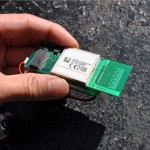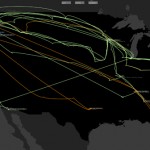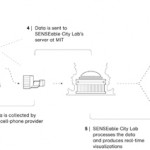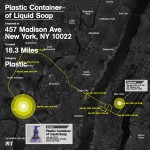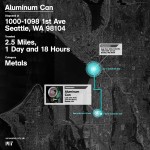Imagine a future where immense amounts of trash didn’t pile up on the peripheries of our cities: a future where we understand the “removal-chain” as we do the “supply-chain”, and where we can use this knowledge to not only build more efficient and sustainable infrastructures but to promote behavioral change. In this future city, the invisible infrastructures of trash removal will become visible and the final journey of our trash will no longer be “out of sight, out of mind”.
Elaborated by the SENSEable City Lab and inspired by the NYC Green Initiative, TrashTrack focuses on how pervasive technologies can expose the challenges of waste management and sustainability. It uses hundreds of small, smart, location aware tags: a first step towards the deployment of smart-dust networks of tiny locatable and addressable microeletromechanical systems.These tags are attached to different types of trash so that these items can be followed through the city’s waste management system, revealing the final journey of our everyday objects in a series of real time visualizations.
The project is an initial investigation into understanding the “removal-chain” in urban areas and it represents a type of change that is taking place in cities: a bottom-up approach to managing resources and promoting behavioral change through pervasive technologies. TrashTrack builds on previous work of the SENSEable City Lab in its exploration of how the increasing deployment of sensors and mobile technologies radically transforms how we understand and describe cities.
The trash tag periodically measures its location and reports that data to the server via the cellular network. In order to ensure a long enough lifetime to track the trash to its final destination, we developed “duty cycling” algorithms, which we use along with in Geo™‘s “Low Duty Cycle” technology which provides hibernation capability that keep the tag off most of the time, turning it on only every few hours to sense and report its position.
Apparently a trivial task, throwing away trash becomes quite distinct when trying to follow its journey object by object. Inserting the Trash Track tags into the waste removal chain requires attention to a number of critical aspects: – achieving a balance in the different types of objects to be tagged and disposed of in terms of component materials, type of technology, object size and product functionality;
– attaching the tags to waste objects involves resolving how to adhere the tags and how to protect them from physical impact and water;
– registering each unique tag number with an object’s name, specifications, context and location of disposal;
– disposing the tagged objects so as to achieve an even distribution related to context and modality of disposal.
While a large part of tagged waste objects were deployed by SENSEable City Lab members during a six day period in Seattle, several volunteers in Seattle were involved in the project in two ways: one group had their daily trash tagged and subsequently tracked, while on another occasion, a Trash Track tagging event was organized at the Seattle Public Library involving the general public. In New York, the SENSEable City Lab together with the Architectural League attached tags to a number of outdated office equipment, which was subsequently thrown away.
When the exhibition opened on 17 September 2009, 500 tags had been deployed between New York and Seattle. In a second phase of the project, this number increased to several thousand tags, involving additional cities.
Credits & info:
Place: New York & Seattle
Date: 2009
Team: Carlo Ratti – director, Assaf Biderman – assoc. director, Dietmar Offenhuber – team leader, Eugenio Morello – team leader / concept, Musstanser Tinauli – team leader / first phase, Kristian Kloeckl – team leader / second phase, Lewis Girod – engineering, Jennifer Dunnam, E Roon Kang, Kevin Nattinger, Avid Boustani, David Lee – programming, Alan Anderson, Clio Andris, Carnaven Chiu, Chris Chung, Lorenzo Davolli, Kathryn Dineen, Natalia Duque Ciceri, Samantha Earl, Sarabjit Kaur, Sarah Neilson, Giovanni de Niederhausern, Jill Passano, Elizabeth Ramaccia, Renato Rinaldi, Francisca Rojas, Louis Sirota, Malima Wolf, Eugene Lee, Angela Wang, Armin Linke – video
Advisors: Rex Britter, Stephen Miles, Tim Gutowski
Lead Volunteers: Tim Pritchard, Jodee Fenton, Lance Albertson, Chad Johansen, Christie Rodgers, Shannon Cheng, Jon Dreher, Andy Smith, Richard Auger, Michael Cafferty, Shalini Ghandi
Partener de proiect / Project partner: WM; Qualcomm; Sprint; The Architectural League of New York
Expozitii / Exhibitions: Toward the Sentient City, The Urban Center, New York (2009), Seattle Public Library (2009), Ars Electronica 2009 “Repair”, Science Museum London (2010), The Interactive Museum of Economics, MIDE, Mexico City
Sprijin / Support: The Architectural League of New York , City of Seattle

